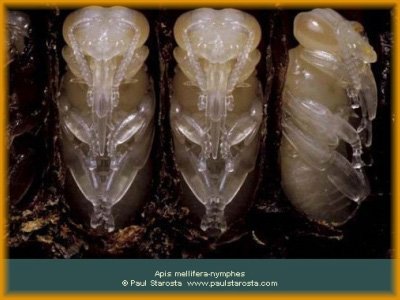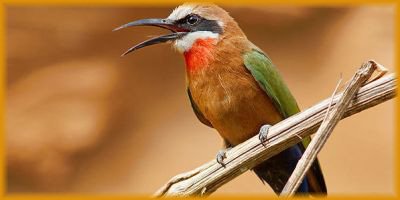
THE MYTH OF THE HONEYBEE

Our society has been conditioned to see Apis Mellifera (aka - Honeybees) as something to be feared. The words "Killer Bee" and "Monster" are erroneously thrown about and used to describe a creature that is, to us, mysterious and without much logic or reason.
We mistakenly refer to wasps, bumblebees and hornets as Honeybees. We run from them or swat them out of midair. We are taught to fear and hate them and that their only job in life is to pester and annoy us.
But in reality, Honeybees look nothing like wasps, hornets or bumblebees. Nor are they violent or prone to fits of aggression against other animal life. They don't kill (unless provoked) and stinging is, quite literally, a last resort defence mechanism used to protect their queen and hive. In fact, there are Honeybees out there that actually have no stinger!
A lot of our perceptions are based on media portrayal. They are confused with other forms of bees and, combined with our own lack of education & understanding of animal life, we grow to fear them.
DID YOU KNOW ..... Honeybees were a sacred insect in Ancient Egypt? According to one Egyptian myth, honeybees were made from the tears of the sun god Ra!
THE REALITY OF THE HONEYBEE
The Honeybee is like all other animal life on this planet. It has parents, responsibilities, a job to do so that its family (the hive) survives, a monarchy complete with queen, illness and disease, males, females and children, natural predators and a life cycle complete with birth, development into adulthood and death!


Male Bee - aka Drone Female Bee - aka Worker
All that and we still have not touched on the fact that Honeybees are actually peaceful creatures that prefer to live in relative privacy and secrecy.
That's right, bees are not violent or prone to attack on a whim, as we're led to believe. They are actually gentle creatures with a very particular hierarchy and, if left alone, are happy to keep making honey and living life among themselves, their only concern being their queen and the prosperity of their hive!
Bees are Eusocial Insects, that means that they live as a community and engage in behaviour that is beneficial to a successful collective. Acting alone, each individual bee is insignificant and does not possess the skills or abilities necessary for survival. But as a colony, the bees can survive for generations and can grow to very large sizes.
DID YOU KNOW ..... Honeybees are the only Insect on Planet Earth that make food that is edible for humans?
THE STING

A sting is a defence mechanism meant to protect the hive and drive an intruder away.
A Bee's sting is believed to be lethal. But the reality is that it is not lethal to humans unless they get stung by hundreds of bees at once or unless there is the presence of allergies.
A sting is usually the last thing a bee will do on behalf of the hive.
Since the stinger is barbed, it will embed itself into the fleshy tissue of vertebrate intruders. When the bee attempts its escape, or when it is flicked away, its stinger and accompanying venom sack and muscles are ripped out in the process. The bee sacrifices its life for the good of the hive in the process of stinging a victim.
The result is that the hive is one bee short, and that the victim gets a sore welt for a few days.
Meeting and upsetting one bee out in a field is nothing to be concerned about. But going near a beehive and alarming one or a few of the bees is an altogether different scenario.
When alarmed, bees release a pheromone (a chemical signal) that triggers a natural response in members of the same species. In the case of an alarmed bee, the pheromone alerts other bees that there is danger and any bees in the vicinity are basically told to protect the hive and queen. The outcome is that an individual or animal is swarmed by a throng of bees and stung simultaneously.
This is the scenario that we are all familiar with. But where it is sensationalized and made to be feared, the reality is that the simple adage of "Live and let live" applies quite well. And unless you go out of your way to threaten a hive, you will never be swarmed like this by bees in this part of North America.
DID YOU KNOW ..... Histamine levels decrease as you age, therefore, it is highly unlikely to suffer from an anaphylactic reaction as a senior?HIERARCHY

Bees are a completely interdependant organism that cannot survive without the other members of its species. This is, quite possibly, the best way to describe bees.
Although we are led to believe that bees are chaotic in nature, in reality the world of bees overflows with structure. Bees NEED structure for their hives to prosper and it is only when there is order and hierarchy that a bee is truly productive (happy?). Order and Hierarchy are brought about by the Queen.
The hive begins and ends with the Queen Bee, although it is a chicken and the egg type of scenario because, without the workers, a Queen Bee does not come to exist. And without the Queen, the hive does not function efficiently, and its numbers do not grow as fast. The existence of a Queen Bee brings about a purpose for the hive as every hive member's primary goal is to ensure the prosperity and survival of the Queen.
Within each hive, there are two types of bees. Male Bees and Female Bees. Queen Bees are a special kind of female bee.
Bee life is Matriarchal in nature. Matriarchy is a social system in which the female is head of household, having authority over men and children. It is a system of government by females, so to speak.
Female Bees are bred from eggs that have been fertilized by a Male Bee's sperm. Unfertilized eggs hatch and grow to become Male Bees.
Every bee undergoes the same development process ....
- First, it is laid as an egg by the Queen Bee
- Next, the Egg hatches and turns into a larva
- The larva is then fed and, when large enough, its cell is sealed with wax and it spins itself into a cocoon.
- Larva becomes a Pupa and undergoes final metamorphosis.
- Finally, an Adult Bee emerges from the Pupa after a period of time.

The development and growth of each type of egg is different for males, females and queens. A male bee will take approximately 24 days to go through its complete cycle of metamorphosis. A female bee will take 21 days to complete her metamorphosis cycle, and a Queen Bee only takes 16 days. The reason for the difference can be attributed to the nutrition that is provided to the larvae and pupa when hatched.
Once fully grown, they leave their cells. They are wet and soft in the first few hours and so each honeybee is cared for and groomed. They must wait a certain amount of time for their exoskeletons to harden and for their wings and hairs to dry. They are indoctrinated into their hive and are given a job to perform once ready.
The Worker Bees are given the job of either a Forager Bee or House Bee and will perform every job in the hive at least once in their life.
The Drones (males) have only one job: Find and inseminate a queen.
DID YOU KNOW ..... In Indonesia, bee larvae are eaten as accompaniment to rice, after being mixed with shredded coconut "meat", wrapped in banana leaves, and steamed?
LONG LIVE THE QUEEN

The queen is the be all and end all of the hive. Her life is committed to selfless service by being the reproductive center of the hive. She has a life span of 5 years. In those 5 years of life, she lays approximately 1,500 eggs per day and only leaves the hive once in her life in order to mate with a number of drones. The more drones she mates with, the longer she is productive.
Without a queen, the hive struggles and grows chaotic. This is because the Queen emits pheremones that govern hive behaviour in all aspects. The worker bees don't forage for nectar and pollen as often, and when they do forage, they bring less back to the hive.
Becoming the Queen Bee is a matter of luck. Queens become Queens only because, as eggs, they had the good fortune of being laid in cells specifically designated for raising queens. These are called queen cups. As larva and pupae, they are exclusively fed “royal jelly” allowing them to become sexually mature and ready to mate. As a by product, they also grow larger than the other female bees in a hive.
There are many Queen Cells in a hive and each of these cells has an egg in it that is rasied in the manner described above. When a Queen Bee completes the metamorphosis and emerges from the cell, the first thing it will do is kill the dweller of every other Queen Cell in the hive. She will eat the eggs that have been laid in the cells and will sting the other developing pupae repeatedly until they are dead. There can exist only one Queen per hive.
When a Queen Bee is ready to mate, it will leave the hive - the ONLY time she will ever leave her hive - and will go to a predetermined meeting area where drones go to meet a Queen Bee. It's essentially a bar seen as every Drone in sight wants to mate with the first female they see. A Queen Bee will mate with many Drones and, when finished, will return to the hive and begin laying eggs.
When the queen grows old, falls ill, slows down egg production or dies, worker bees once again designate queen cells and raise new virgin queens. Once the new Queen is born, the old Queen is pushed to the side and allowed to die naturally. If the population of the hive becomes to large for the space, and the worker bees cannot smell the Queen pheremone, they will think they have no queen. This triggers the formation of queen cups on the bottom bar and many times the top bar of the frames. These queen cups are called swarm cells. As it gets closer to the time for these queens to emerge, the old queen will leave her hive and a certain portion of that hive population will leave with her in order to form a new hive. The new, virgin Queen will take over the duties of running the hive and will go through the same phases of life and development that the other Queen(s) have gone through before. This is the natural way of creating new hives and garantees the ongoing existance of honey bees naturally.
DID YOU KNOW ..... The Drone's sperm will be stored by the Queen in a special organ called a Spermatheca and she will selectively use the sperm throughout her entire life to breed her colony.
A HARD WORKER
The females of the hives, also known as Worker Bees, do all the work that is necessary to keep the hive running. Unlike the Drone Bees, Worker bees are designated responsibilities and tasks to perform throughout their entire life spans. These tasks vary according to the age of the worker bee.
In the Hierarchy section, we discussed that the 2 primary jobs are House Bee and Forager Bee. But within each of these two jobs, there are various tasks that are involved and performed.
For the young, recently emerged Worker Bees ....
| Task | Description | Comments |
|---|---|---|
| Janitor Bee | Clean Brood Cells and prepare them for their next use | The Queen Bee personally inspects each cell and, if unsatisfactory, it will not be used and the bee must clean it again. |
| Nurse Bee | Feed the worker larvae worker jelly which is secreted from glands that produce royal jelly. | |
| Advanced Nurse Bee |
Feed royal jelly to the Queen larva. | All Drones are fed worker jelly for 1 to 3 days at which time they are started on a diet of honey and pollen, also called Bee Bread. |
| Wax Bee | Build cells from wax, repair old cells, and store nectar and pollen brought in by other workers. | Early in the worker's career she will exude wax from her four sets of wax glands. It comes out as thin flakes that are mixed with saliva and molded into shape. |
For the older Worker Bees ....
| Task | Description | Comments |
|---|---|---|
| Honey Sealing | Prepare honey for long term storage and use during winter | Mature honey, sufficiently dried, is sealed tightly with wax to prevent absorption of moisture from the air by workers deputized to do so. |
| Queen Attendants |
The attendants groom and feed the queen. They also collect QMP (Queen Mandibular Pheromone) from the queen and share it with the bees within the hive. | This is how bees are assigned work. The QMP is spread and its effects are disseminated through the hive. QMP also serves to tell the worker bees NOT to NOT raise new Queens. |
| Honeycomb Building |
Workers will take wax from wax producing workers and build the comb with it. | It takes approximately 5-7 days for the first wax comb to be produced. |
| Pollen Packing | Pollen brought into the hive for feeding the brood is prepared and stored. It must be packed firmly into comb cells and mixed with a small amount of honey so that it will not spoil. | Unlike honey, which does not support bacterial life, stored pollen will become rancid without proper care. It has to be kept in honey cells. |
| Propolizing | The walls of the hive are covered with a thin coating of propolis, which has antibacterial and antifungal properties. | Propolis is like a glue that is made from plants and enzymes provided by the bee. It is used at the hive entrance and to aide with ventilation. |
| Undertaker Bees | Dead bees and failed larvae must be removed from the hive to allow cells to be reused. They will be carried far from the hive by Undertaker bees and left in the same general area to rot. | Removing dead bees prevents disease, undesirable scavengers and fungus from damaging the hive. |
| Fan Bees | Bees fan the hive, cooling it with their wings and evaporated water brought by water carriers. | Airflow is directed into or out of the hive depending on time of year and need. |
For the oldest Worker Bees ....
| Task | Description | Comments |
|---|---|---|
| Soldier Bee | Soldiers guard the entrance and attack invaders. | They work in concert with entrance guards. |
| Entrance Guard Bee |
Inspect incoming bees to ensure that they are bringing in food and have the correct hive odor. Other bees will be rejected or attacked with soldier bees. | Pheromones are released when an intruder or alien bee attempts to enter the hive. The pheromones alert the Soldier Bees to come to their hive's defence. |
| Outside Guard Bee |
These guards are primed and ready to respond to disturbances outside the hive. | They help the Soldier Bees subdue or scare away intruders. |
| Water Bee | These bees go to water sources and bring it back to the hive for storage or hive cooling use, when found. | The water is spread on the backs of the Fan Bees. Water is stored in a special storage space just for water. |
| Scout Bee | These bees scout the area for pollenating flowers and water sources. | When a source of water or food is found, the bees come back and do a dance to let the hive know the distance and direction of food and water. |
| Forager Bee | Travel to pollenating flowers and water sources and bring back nectar, pollen or propolis for hive. | These jobs are reserved for the oldest bees and they can travel up to around 2.5km for supplies. |
Worker Bees are infertile and cannot reproduce, but they are considered females regardless because of their genetic composition. In some cases they become Laying Workers which is to say that they lay eggs into the cells. However, since they don't go on mating trips, they only ever produce Drones. Thus, the use of Laying Worker Bees is limited and this does not happen often as the Queen takes care of creating the hive's offspring.
Although the Queen Bee is capable of stinging intruders, Worker Bees are the ones that generally come to the aid of the hive and use their stingers. For information on Bee Stings and how that works, please read our Bee Sting section above.
DID YOU KNOW ..... Honey was regarded as a symbol of resurrection and also thought to give protection against evil spirits in Ancient Egypt?
LONE DRONE

As described above, Bee Society is a Matriarchy. And nowhere is this more apparent than when we look at the Drone Bee. The Drone bee is made from an unfertilized egg that is laid by either a Queen or a Laying Worker. It's development from egg to bee clocks in at 24 days, the longest of all honeybees. It is fed less and the food it receives is of lower quality.
A Drone bee is born without a stinger, therefore it is basically defenseless and, as a result, it is seen as useless to the hive. Unlike the other bees, it does not feed itself. Instead, it is fed by the Worker Bees. It is not given any task to do for the hive on behalf of the queen and it lives only about 90 days. If a Drone is lucky, it will mate once with a queen before death.
At given points in the year, the Drones of a hive leave their home and congregate in designated areas away from the hive and await Queen in order to mate with her. A Drone is also different from the other bees in a hive in that it is born with extremely large eyes that are used to spot a mating Queen. When a Queen arrives, she will mate with multiple Drones before returning to the hive.
A Drone is born with an Endophallus, which is essentially a barbed penis. When a Drone mates with a Queen, it mounts the Queen and inserts its endophallus. Its endophallus remains stuck inside the Queen throughout the mating session and, as she flies away or he gets off after mating, the endophallus and the Drone's abdomen are ripped out. So the bee is essentially disemboweled and it dies shortly after mating.
Since the Queen mates with multiple Drones, that means that another Drone generally approaches the Queen in an attempt to mate with her. But before the subsequent Drones can mate, they must remove the previous Drone's endophallus. After this is done, each subsequent Drone will go through the same process as the first.
Once the Queen is finished mating, she and the remaining Drones will return to the hive. The Queen to do her job, the Drones to wait.
In the fall, the hive performs many tasks in preparation for winter. One of them is to drag all of the existing Drones out of the hive and either sting them to death or to let them freeze outside. Any Drone larvae that is born is either eaten, stung to death or dragged out and dropped in the freezing climate to die.
In a typical hive, you can find upwards of 50,000 Worker Bees, yet you will only ever find a few hundred Drones.
Though useless in most respects, the Drone is just as necessary for hive survival because without the Drone's sperm the only thing a Queen will lay are more male eggs. And though it is defenseless and harmless, it does at least try to imitate the behaviour of worker bees when alarmed or threatened by thrusting its abdomen towards a potential inruder in order to make it look like it might sting. The reality is, however, that it can do nothing aside from trying to scare away an intruder.
DID YOU KNOW ..... A bee must collect nectar from about 2 million flowers in order to make 1 pound of honey. A hive requires 556 worker bees to gather a pound of honey. Bees fly more than once around the world to gather a pound of honey. One worker bee will make about 1/12th of a teaspoon of honey in her lifetime.
BEE PREDATORS

Like all members of the food chain, Honeybees have Natural Predators that hunt them. And why not? Their food is obviously some of the most delicious and nutritious throughout the entire world! Here are just a few of the other members of the animal kingdom who share a love of bees with us ...
Winnie the Pooh popularized the idea that Bears love Honey. And while they do indulge in a Honey craving or two, they are just as apt to attack a beehive for the sweet taste of .... bee larvae. Yes, that's right. Bears will open up the beehive and eat the larvae that are in the process of development. Skunks are efficient killers and notorious for attacking beehives at night time. Opossums and Raccoons are two other mammals that prey on Honeybees. Beekeepers often set up electric fences to keep bears out and traps to catch skunks and other nocturnal mammals.
Wasps and hornets love to eat bee larvae. They'll settle for a little honey too. In Japan, wasps grow to be about 2 inch in size and they are especially brutal when attacking a beehive. As a result, the native Japanese Honeybees have developed a defensive technique called The Bee Ball.

Spiders use several methods to get them. One species of Spider likes to hide inside flowers and wait til a bee gets near. Since a bee visits a flower and dives in head first to collect nectar and pollen, it usually gets whatever the spider has to give in the head. Other insects that prey on Honeybees are Dragon Flies and certain species of Flies.
Within the Aves Class of the Animal Kingdom - also known as Birds - we have Grackles, Hummingbirds and a particular bird called the African Bee Eater which, as the name suggests, enjoys eating members of the bee species and usually snatches them right out of mid air. These birds have gotten smart enough to know that before eating a bee, the stinger must be removed and so, they rub the bee against a hard surface until the stinger comes off and the venom is squeezed out. Here on the prairies, two of the most common avian predators are the chickadee and the barn swallow
But of all the predators, it could be said that Human Beings are the most common and most dangerous. You can read more about the impact that Human Beings have on the Honeybee by visiting our Bee-Cosystem page.
DID YOU KNOW ..... A bee has a total of FIVE eyes? It has 3 Ocelli, or Simple Eyes, on the top of its head and 2 compound eyes that are at the front!
